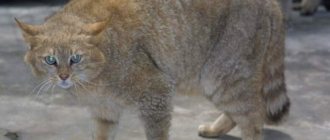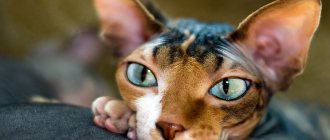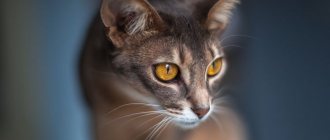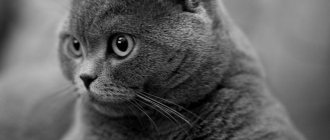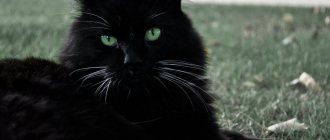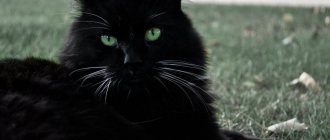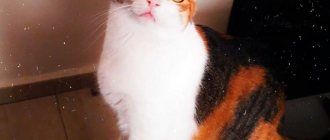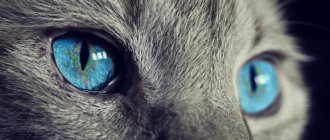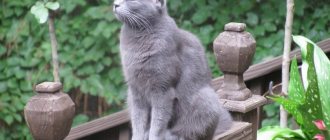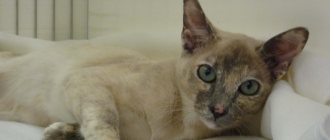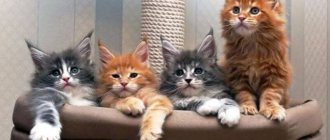Persian
Long silky hair (of any color), round green or yellow eyes, a flattened muzzle with an upturned nose - these are the characteristic features of a purebred Persian. His character can be either capricious or pliable, calm.
Thanks to the long, thick fur, the size of the Persian cat visually increases, but after a bath you can be very surprised by the size of the pet, because they will be much smaller than it seems.
Among the representatives of this cat breed there are also their own types:
- Classic (nose slightly below the eye line).
- European (the edge of the nose is at the same level as the lower eyelid).
- Extreme (nose in line with the inner corners of the eyes).
How to care?
Flat-faced cats need proper care. Let's look at how to take care of these cute pets.
- Take care of your cats eyes. There is no need to constantly wash your eyes with water, especially if you have a Persian cat. It is better not to use cotton wool for processing - its lint can get into your eyes. When carrying out the procedure, use a paper napkin or cloth. They are moistened with a weak solution of boric acid or special drops, and then the cat’s eyes are cleaned, you can use the “Optic-gel” product.
- Give cats dry food to prevent the accumulation of plaque and tartar on the teeth. You can buy a chew toy. Brush your pet's teeth with a special paste at least once a month. Use a special brush purchased at a pet store.
- Check the ears of flat-faced cats regularly. Clean your ears with cotton swabs at least once a month. As soon as your pet's ears become dirty, they should be cleaned immediately.
- Take care of the normal condition of the animal's claws. Buy or make a scratching post. Trim your nails once a month using a nail clipper. Cut off the excess part evenly and capture no more than 2 mm.
- Brush long-haired pets every day, bathe cats. If the coat is long, then this should be done once every 8-12 weeks.
- Feed your pet high-quality natural food or premium and super-premium food. You cannot feed salted, smoked, fried, fatty, sweet foods, as well as cheap economy-class food.
See below about the characteristics of exotics.
Exotic Shorthair
In shortened form, this breed of cat with a flattened muzzle and large eyes is called exotic. She owes her appearance to the crossing of Persians with an American shorthair cat. In appearance, exotics are very reminiscent of extreme Persians, but unlike the latter, they have short, soft hair, which saves owners from the need to spend a lot of time on regular grooming. Among the characteristic features: strong short legs, an expanded chest and large size (the weight of some animals exceeds 8 kg). The color of representatives can be very diverse, from white and black to noble blue.
The cute plush appearance of the exotic cat fully matches its character. These pets differ from their Persian ancestors in a more affectionate, playful disposition, without unnecessary aggression, and therefore are considered an ideal option for families with children. They rarely speak, love their owner very much and get along without problems in the same territory with other animals.
The history of flat-faced cats
It is generally accepted that people domesticated the first cats about 12 thousand years ago. Moreover, at that time these were wild animals living on their own in natural conditions. And various cat breeds began to actively appear in the last few centuries, as specialists bred various animals with a specific skeletal structure and coat color to suit different needs and requests.
The history of flat-faced cats begins around 500 BC. The Dutch traveler noted in his notes that he saw amazing cats with long and fluffy hair at the court of the first kings of Persia, Cambyses and Darius.
It was the Persian kings who were the first to glorify the new breed of cats; Cats got their name from the name of the state
Thanks to his beautiful appearance, the future progenitor of Persian cats (and this is how the story of the appearance of “Persians” in the world begins) was the favorite of many royal and noble persons. The preservation of the randomly obtained breed was ensured until the 16th century, when the Persian cat was brought to Europe.
Here, the “Persians” also became favorites at the courts, and therefore the development of the breed continued to the form that we can see today.
Felinological organizations are very sensitive to determining whether an individual belongs to a particular breed. Thus, according to various estimates, from 35 to 74 cat breeds are still recognized in the world. The Persian cat is one of those breeds that have been recognized by all felinologists in the world.
And, for example, British cats were originally called “shorthair” in England and were registered as a separate breed in the 1930s. However, the history of the breed goes back to the Middle Ages, when, due to a gene mutation, cats with flattened faces began to appear at the court of the English nobility.
Around the 1920s and 1930s, Sweden and the United States began crossing Siamese and Persian cats, eventually creating a new breed, the Himalayan cat. Only by 1980 was it possible to consolidate breed standards and distinguish the Himalayan as a separate species of cat.
In the 1960s, Persian and American Shorthair cats were crossed in the United States. As a result, a new breed appeared, called exotic. Exotics initially frightened breeders with their appearance, but the breed quickly gained popularity: first in the USA, and then in other countries of the world. In the early 1980s, exotics were legalized as a full-fledged cat breed.
The story of the Scottish cat begins very unexpectedly: the farm cat Susie was born with a strong mutation (brachycephalic skull shape and small ears bent forward). In the 1960s, there were no such pets in Scotland, so Susie's offspring were crossed with British cats. As a result, it was possible to create a new breed, which was named Scottish in honor of the place of residence of the ancestor cat.
Scientific point of view
A cat's unusual flattened face is the result of a serious genetic disorder. In scientific circles, this phenomenon is called “brachycephaly.” The term is literally translated from Latin as “short head” and indeed, in brachycephalics, the length of the head occupies up to 80% of the width of the skull and is strongly flattened in front.
The skeleton shows that the skull has a rounded surface and is flattened in the front.
There is a point of view that domestic cats inherited this skull shape from their common ancestor - the wild cat Pallas's cat. However, whether this is actually the case is not known for sure.
Geneticists and breeders have worked to ensure that, over the course of all generations, the brachycephalic features of the skull have been fixed in some cat breeds. The work was carried out in such a way that only those individuals whose flattened muzzle was the main feature were crossed.
Himalayan
Another breed of cat with a short nose is the Himalayan, obtained from crossing Persians with Siamese. It is recognized only by the TICA and CFF associations. Others consider it a subspecies of the Persian and register it that way.
In addition to the snub nose, the distinctive features of the Himalayan's appearance include bright blue eyes, a large body with short legs and increased fluffiness. The coat color is color point with transitions from beige on the body to dark brown on the nose, ears, tail and limbs.
Pets of the Himalayan breed are distinguished by a calm, even lazy character: they rarely play, and like to sleep more than others. Due to this lethargy, they can be called ideal pets for cuddling.
With some stretch, British Shorthair and Scottish Fold cats can also be considered breeds with a flat nose. The brachycephalic type of skull is not as pronounced in them as in the Persians, Exotics and Himalayans presented above.
Brachycephalic cat breeds
List of brachycephalic breeds:
- British Shorthair;
- Scottish lop-eared;
- Himalayan;
- exotic;
- Persian
Exotic cat CFA (Cat Fanciers Association) annually publishes a ranking of the most popular breeds. For many years, kittens with flattened faces have been at the top of the rankings, which indicates their popularity.
British Shorthairs with a slightly flat nose
British Shorthair The British cat is characterized by a round, plump muzzle, slightly sagging cheeks, and small, neat ears.
The animals have a squat, dense body and strong limbs. In British cats, brachycephalic syndrome manifests itself to the least extent. They are distinguished by a short, wide and straight nose, which forms a vertical line with the chin.
British Shorthair cats are self-sufficient, they tolerate loneliness calmly and do not like noisy companies and active games. They are great for singles who spend a lot of time at work. These animals have a sense of self-esteem, so they expect respect from others.
Manul
Despite the fact that breeds with a flattened face are bred artificially, there are also cats in nature with this feature. This is a Pallas's cat that lives in the countries of Central Asia. It is approximately the same size as its domestic relatives, but has a more “predatory” appearance: a squat, massive body with short legs, a flat skull with a powerful jaw, and very thick long hair. The image is complemented by a small head with small rounded ears and yellow eyes.
Thanks to its brachycephalic skull, the Pallas cat has two advantages. Firstly, a strong jaw, which allows you to firmly hold your prey. Secondly, the ability to breathe through your mouth, so as not to loosen your iron grip even for a minute. The color with a combination of light gray and yellow-brown shades provides reliable camouflage in the wild, which is especially important during hunting. Pallas's cat is a rare species of animal and is listed in the Red Book. Despite this, there are those who want to domesticate it, which is almost impossible to do in reality.
Minuses
- Since the flattened shape of the face is not natural for cats, some problems arise from this. And sometimes in the literal sense of the word. These cats often have problems with nasopharyngeal congestion. A cat may snore and snort in its sleep. It's noisy.
- The brachycephalic type of muzzle in some people causes associations with an angry facial expression. This cat seems to be constantly dissatisfied with something. Or, on the contrary, it looks very naive. This form is also called a “doll” because it can resemble a child’s face. The associations are completely contradictory to each other, but they do exist.
Features of care
Many people like flat-faced cats for their innocent expression and unusual appearance. But if you want to become the owner of such a pet, you should take into account the possible difficulties of keeping them:
- Breathing problems. Due to their narrow, shortened airways, flat-faced cats often wheeze and snore while sleeping and even while feeding. They have a particularly difficult time with nasal congestion due to colds, so when choosing a Persian or exotic as a pet, it is especially important to regularly monitor the air temperature in the house and prevent hypothermia.
- Increased tear production. Due to shortened tear ducts, the risk of developing infection and suppuration under the eyelids increases. To prevent complications and for preventive purposes, watery eyes should be wiped with a cloth or paper napkin moistened with a special solution.
- Features of feeding. First, the food bowl must be wide enough. Secondly, not all pets can eat carefully. Despite the natural cleanliness of cats and regular licking, periodically the hair in the neck and mouth area needs to be wiped with a damp sponge. Some animals cannot eat food on their own at all, so owners have to spoon feed them.
Advantages and disadvantages of “snub-nosed” cats
The flattened muzzle of cats is considered a highlight, giving them recognition. Thanks to this, such breeds have a number of advantages:
- a touching appearance is liked by many people and distinguishes them from most non-pedigreed individuals;
- a calm, good-natured character and friendliness towards everyone simplifies adaptation to any family;
- the special shape of the skull makes the animal’s jaw stronger, which helps during hunting and avoids injury.
A depressed skull brings a number of inconveniences to the cat itself, including:
- breathing problems, including snoring or wheezing sounds;
- short tear ducts lead to constant discharge from the eyes;
- it is difficult to pick up and absorb food from ordinary dishes;
- tendency to colds due to impaired thermoregulation;
- severe allergies, colds and other diseases.
Such cats require special care and attention from their owners, so the price and cost of maintaining a purebred pet will be considerable.
